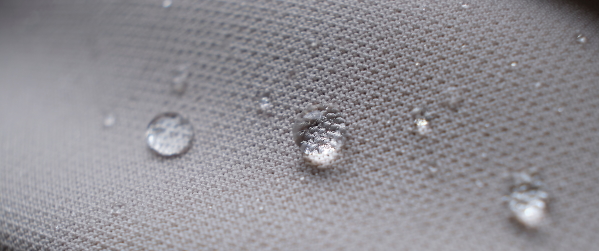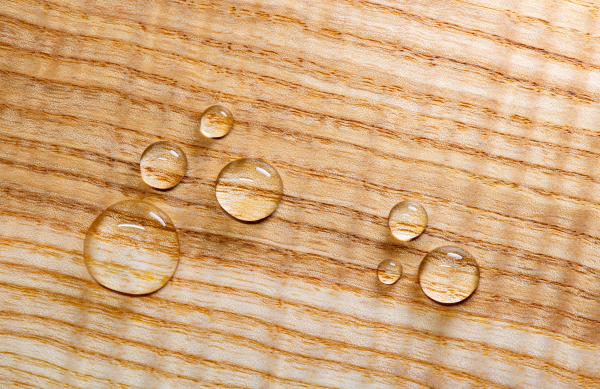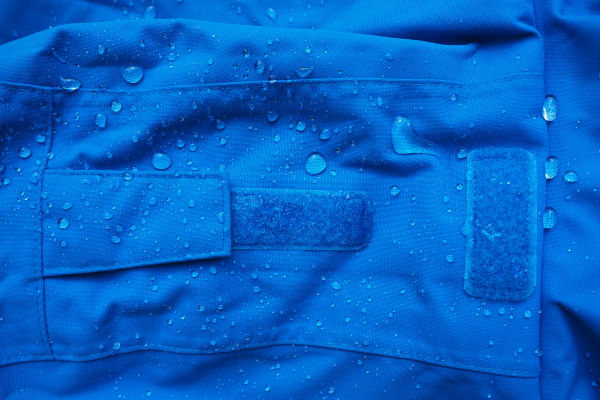Impregnations are used to protect against moisture, dirt and UV radiation. But not only textiles, but also paving stones, tiles, concrete and wood can be impregnated. Thanks to the protective coating, the products remain visually attractive for a long time and do not quickly deteriorate in quality.
In order to be able to be active outdoors in wind and weather without getting soaked, the right equipment is necessary. But even the best equipment loses its protective function with time and constant use. Impregnating agents are used here to give the products their longevity and permanent protection against wind and weather.

Fig.1: Impregnation protects the material from becoming soaked.
What are impregnating agents made of and how is the permanent protection created?
Impregnation does not mean that a product is made waterproof, but rather that it has a water-repellent effect. Individual drops of water do not become a whole film of water, but the drops bead up on the surface. The coating can also have an oil- and dirt-repellent effect and is also often used to protect the material. In the chemical industry, this protection is often based on fluorocarbon compounds.
Through frequent wearing of garments or frequent/continuous use of containers and various materials, the protection of the impregnation wears off after a certain time. For a permanent result, the products must be impregnated again at regular intervals.
Substances frequently used for impregnation:
- Paraffin emulsions
- Wax emulsions
- Fluorocarbons = polyfluorinated surfactants
- Silicone emulsions
Paraffins, aluminium and zirconium salts, silicone emulsions, fluorocarbon resins, beeswaxes, synthetic resins and silicones are used for the composition of impregnating agents. For a permanent protective layer, wax and paraffin emulsions and also film-forming silicones and fluorocarbons are used.
Fluorocarbons (PFCs) belong to the group of per- and polyfluorinated chemicals; these substances are highly resistant to UV radiation, heat, moisture, dirt and other environmental influences. Copolymers of perfluoroalkyl acrylates and methacrylates are often used here. Paraffins and waxes form a water-repellent protective film.
Application of impregnating agents
Building materials are impregnated in water-repellent agents to protect them from water absorption. For wood, there are various methods consisting of dipping, spraying and pressure impregnation. For concrete, impregnation serves as surface protection by coating.

Fig.2: Impregnated wood
Textiles are made water and dirt repellent by wash-in impregnation and impregnation sprays. In the case of wash-in impregnation, the product is washed with the impregnating agent by hand or in a washing machine and thus acquires the desired protection. When applying an impregnation spray, the product must stand for a short time, depending on the spray's specifications, until the protective film forms. The process should be repeated as soon as the material becomes roughened.

Fig.3: Water-repellent clothing is especially important in autumn and winter.
-
In the electronics sector
In the electronics sector, the cavities between wires in a component such as an electric drive motor must be sealed with an insulating material. This helps to improve performance and extend the operating life of the drive motor, especially in various forms of motors, generators and pumps, as well as in the coils of transformers or transformer transformers.
Impregnations and the environment
Fluorocarbons, per- and polyfluorinated substances cannot be biodegraded. The production, washing and use of impregnated products releases these substances into waste water and the environment. The chemical residues of these substances can hardly be removed. Therefore, more and more manufacturers are doing without the environmentally harmful substances and are more frequently offering alternatives without polyfluorinated and perfluorinated chemicals.
 www.donauchem.at
Sources and related links:
https://www.chemie-schule.de/
https://www.rw-textilservice.de/nicht-nur-wasserabweisend-impraegnierung-von-textilien/150/17391/368785
https://www.stoff4you.de/stoff-lexikon/impraegniermittel/
https://www.stoff4you.de/stoff-lexikon/fluorcarbon/
https://www.bergzeit.at/magazin/impraegniermittel-fragen-antworten/
https://blog.eschuhe.de/wie-wirkt-ein-wasserabweisendes-impraegniermittel/
https://nano-care.com/de/impraegnierung/dwr/
www.donauchem.at
Sources and related links:
https://www.chemie-schule.de/
https://www.rw-textilservice.de/nicht-nur-wasserabweisend-impraegnierung-von-textilien/150/17391/368785
https://www.stoff4you.de/stoff-lexikon/impraegniermittel/
https://www.stoff4you.de/stoff-lexikon/fluorcarbon/
https://www.bergzeit.at/magazin/impraegniermittel-fragen-antworten/
https://blog.eschuhe.de/wie-wirkt-ein-wasserabweisendes-impraegniermittel/
https://nano-care.com/de/impraegnierung/dwr/
https://www.bdtronic.com/de-de/impraegniertechnologie/impraegnieren-anwendungsbereiche/